Nordic Studies on Alcohol and Drugs (NAD)
Here you will find the articles published in the scientific journal Nordic Studies on Alcohol and Drugs.
NAD 1/2024
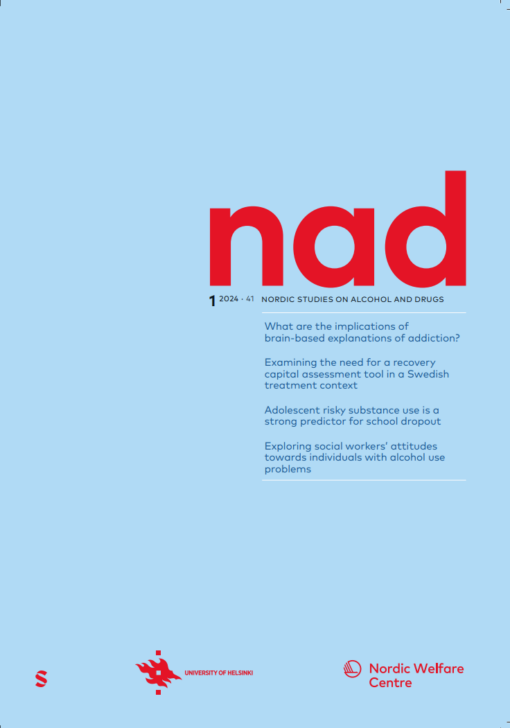
Read the latest issue of NAD here
Editorial
Tom Kettunen & Mikaela Lindeman: Bridging academia and Nordic Societies
Research reports
Ove Heradstveit, Mari Hysing, Tormod Bøe, Sondre Aasen Aasen Nilsen, Børge Sivertsen, Anne Line Bretteville-Jensen, Kristin Gärtner Gärtner Askeland: Prospective associations between adolescent risky substance use and school dropout and the role of externalizing and internalizing problems
Doris Ochterbeck, Jennifer Frense, Sarah Forberger: A survey of international addiction researchers’ views on implications of brain-based explanations of addiction and the responsibility of affected persons
Katy Holloway, Marian Buhociu, Shannon Murray, Wulf Livingston, Andrew Perkins: Assessing the early influence of COVID-19 in any analysis of the immediate implementation of Minimum Pricing for Alcohol on drinkers in Wales
Justina Kievišiene: Exploring social workers’ attitudes towards individuals with alcohol usage problems – a quantitative study from Lithuania
Kaisu-Leena Mäkelä, Jari Kylmä, Anna-Maija Koivisto, Tiina Hakala, Marita Koivunen: Validation of the Nurses’ Skills to Care for Alcohol-Intoxicated Patients in Emergency Department (NSCAIP-ED) instrument
Overview
Ellen Amundsen, Anne-Karine Markeng Markeng Melsom, Bjørn Eriksen, Maja-Lisa Læchen:
Why did drug overdose deaths not decrease after 2010? Norway as a case study.
NAD 6/2023
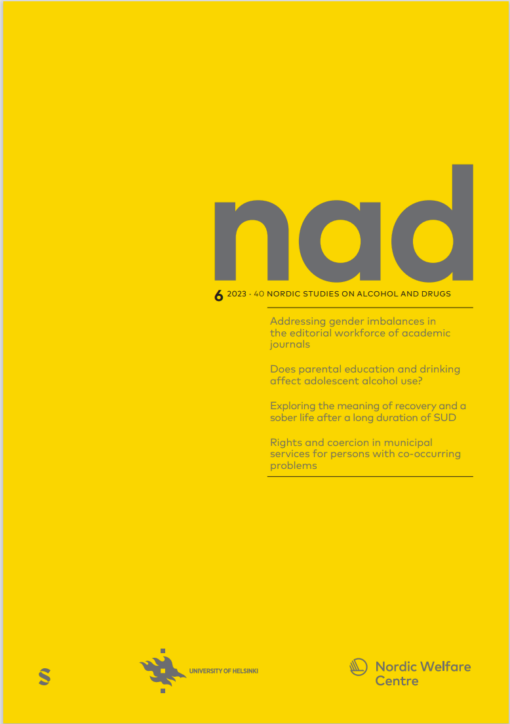
Read the latest issue of NAD here
Editorial
Matilda Hellman: Celebrating 40 years of Nordic collaboration
ISAJE position paper
Thomas Babor, Anna Tsiboukli, Matilda Hellman & Anees Bahji: Ways to get a more balanced gender representation in addiction journals’ management and workforce
For Debate
Petter Grahl Johnstad: Why are the police against drug policy liberalisation?
Research reports
Gunn Pettersen, Trond Nergaard Nergaard Bjerke, Ellen Margrethe Margrethe Hoxmark, Njål Herman Eikeng Herman Eikeng Sterri, & Jan H Rosenvinge: From existing to living: Exploring the meaning of recovery and a sober life after a long duration of a substance use disorder – an interview study
Ane Bendixen, Hildegunn Sagvaag, Bjørn Henning Østenstad, & Trond Gronnestad: Rettigheter og tvang i kommunale hjelpetilbud til personer med alvorlige samtidige rus- og psykiske lidelser – en kvalitativ studie om erfaringer med regelverket, i lys av menneskerettigheter
Joakim Wahlström, Charlotta Magnusson, Johan Svensson, & Sara Brolin Låftman: Problematic familial alcohol use and adolescent outcomes: do associations differ by parental education?
Ali Unlu, & Aleksi Hupli: Mix-method social media analysis of the Greens cannabis legalization proposal in Finnish-speaking Twitter
NAD 5/2023
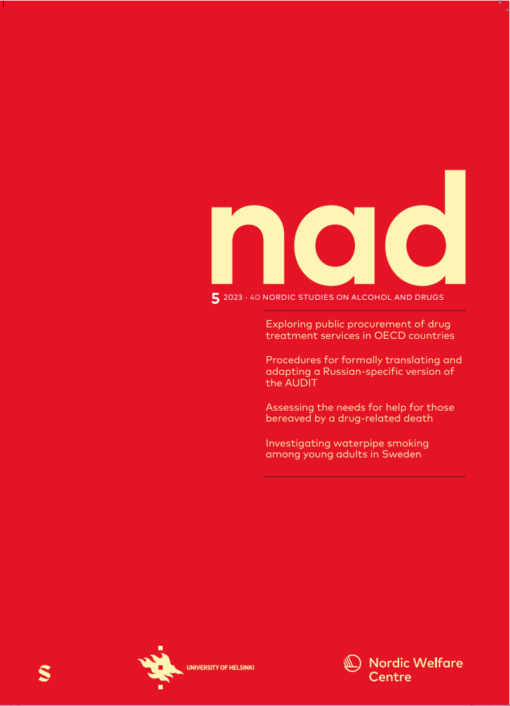
Read the latest issue of NAD here
Editorial
Matilda Hellman: Evidence for improving welfare services
Reviews
Taina Schneider, Kristiina Kuussaari & Petri Virtanen: Drug treatment service procurement – a systematic review of models, goals, and outcomes
Tiril Cecilie Cecilie Borge & Ashley Elizabeth Elizabeth Muller: Overdosevarslingssystemer – en kartleggingsoversikt med maskinlæring
Research Reports
Øyvind Reehorst Reehorst Kalsås, Kristine Berg Berg Titlestad, Kari Dyregrov & Lars Thore Thore Fadnes: How to improve services to bereaved by drug-related deaths? Investigating bereaved family members and close friends` needs for help and received help: A cross-sectional study.
Pelle Pelters & Maria Rosaria Rosaria Galanti: “It’s nice to just be” – A qualitative study on the meaning-imbued reality of waterpipe smoking among young adults in Sweden
Kirsten Frederiksen, Morten Hesse & Mads Uffe Uffe Pedersen: Problematic parental substance use, childhood family structures and adverse outcomes in young adulthood
Sidsel Karsberg, Adriana del Palacio Gonzalez, Michael M. M. Pedersen, Kirsten Frederiksen & Mads Uffe Uffe Pedersen: Do adverse experiences predict unemployment and need of psychiatric help after treatment for drug use disorders?
Maria Neufeld et al: Translating and adapting the Alcohol Use Disorders Identification Test (AUDIT) for use in the Russian Federation. A multicenter pilot study to inform validation procedures
NAD 4/2023
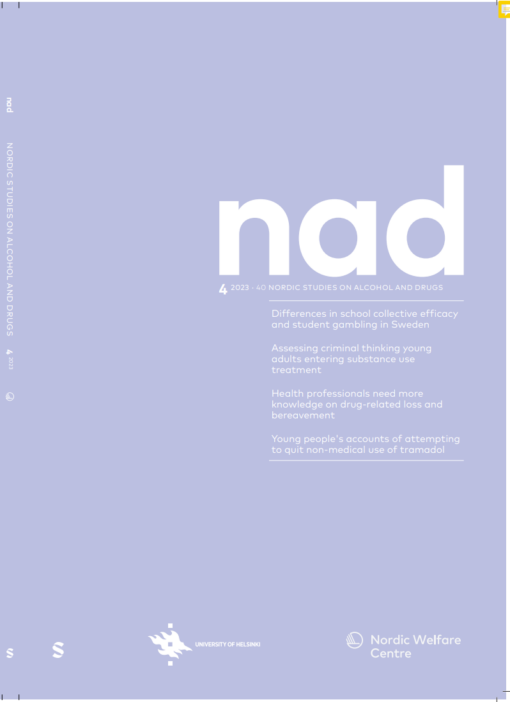
Read the latest issue of NAD here
Editorial
Matilda Hellman: Yet another alcohol policy experiment in Finland
Research reports
Gabriella Olsson, Bitte Modin, & Sara Brolin Låftman: School collective efficacy and gambling: A multilevel study of 11th grade students in Stockholm
Regine Bakken, Lars Lien, Halvor Fauske, Jūratė Šaltytė Benth, & Anne Signe Landheim: Criminal thinking and psychosocial characteristics among young adults entering residential substance use treatment
Kristin Arve: “You get stuck in it”: Young people’s accounts of attempting to quit non-medical tramadol use
Hilde-Margit Løseth, Lillian Bruland Selseng & Kari Dyregrov: Barriers and facilitative factors in the provision of first-responder services to persons bereaved following a drug-related death: A qualitative study
Malin Hildebrand Karlén et al: Prevalence and heritability of alcohol use disorders in 18-year old Swedish twins
For debate
Selma Ercan Doğu & Esma Özkan: The role of occupational therapy in substance use
Book review
Virve Marionneau: Book review: Games without frontiers?
NAD 3/2023
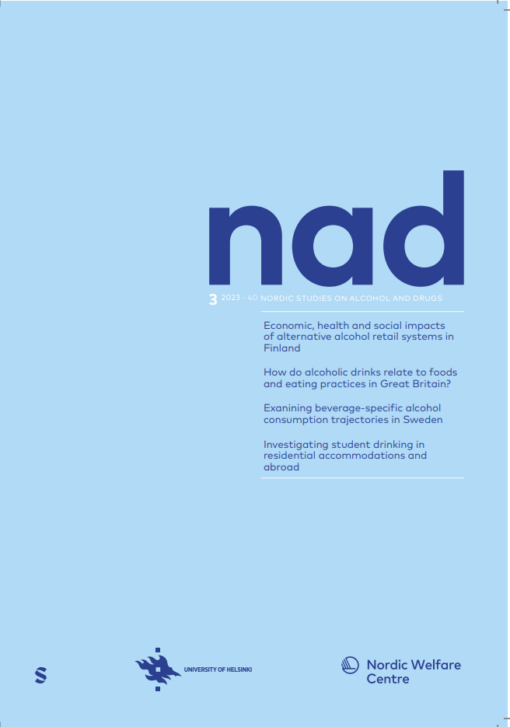
Read the latest issue of NAD here
Editorial
Tom Kettunen: Our content is relevant and on track
Research Reports
Adam Sherk, Tim Stockwell, Justin Sorge, Samuel Churchill, Colin Angus, Tanya Chikritzhs, John Holmes, Petra Meier, Timothy S. Naimi, Thor Norström, Mats Ramstedt, Jussi Simpura: The public-private decision for alcohol retail systems: Examining the economic, health and social impacts of alternative systems in Finland
Anna Sidorchuk, Karin Engström, Jette Möller, Katalin Gemes: Predictors of beverage-specific, alcohol consumption trajectories: a Swedish population-based cohort study
Vibeke Müller, Johan Jarl, Ulf-G. Gerdtham: A Measure of Alcohol Affordability for Sweden – Capturing trends among different demographic groups
Rose Leontini, Tim Corney: Student Drinking Cultures in Tertiary Education Residential Accommodation: A Contextual Research Study
Emil Danehorn, Marie Oscarsson, Goldina Smirthwaite, Ulla Peterson, Katarina Swahnberg: Swedish Exchange students’ alcohol use, drug use, risky sexual behaviour, mental health, and self-rated health: a follow-up study
Alan Warde, Alessandro Sasso, John Holmes, Monica Hernandes, Abigail Stevely, Petra Meier: Situated drinking: the association between eating and alcohol consumption in Great Britain
Commentary
NAD 2/2023
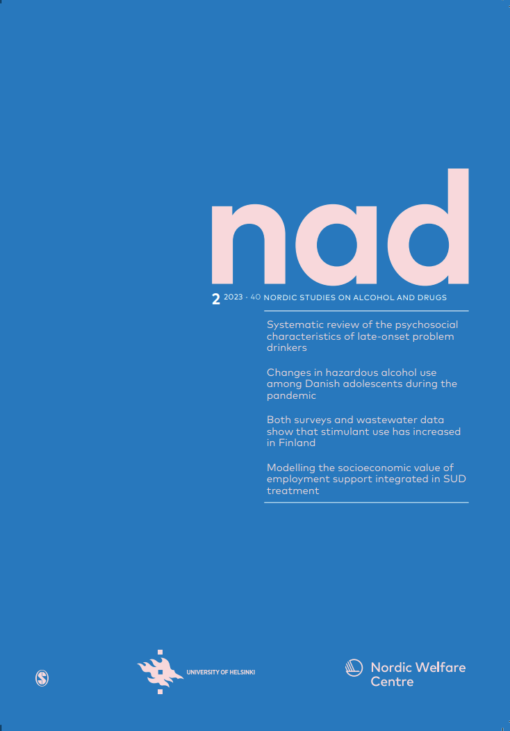
Read the latest issue of NAD here
Editorial
Matilda Hellman: Alcohol, drugs, gambling and tobacco form a lens for the Nordic welfare states’ biggest challenges
Review
Kevin Joseph McInerney, David Best, Ainslea Cross: Characteristics of People who have Received Treatment for Late-Onset Problem Drinking and Alcohol Use Disorder: A Systematic Review and Narrative Synthesis
Research Report
Lotte Vallentin-Holbech, Sarah W. Feldstein Ewing, Kristine Thomsen: Hazardous alcohol use among Danish adolescents during the second wave of COVID-19: link between alcohol use and social life
Marije aan het Rot, Isabelle C Bulai, Violeta Enea: Increased alcohol use to cope with COVID-19-related anxiety one year into the coronavirus pandemic
Karoliina Karjalainen, Teemu Gunnar, Pekka Hakkarainen, Aino Kankaanpää, Sanna Rönkä: Analysis of illicit stimulant use triangulating wastewater, general population survey and web survey data
Anne Koponen, Niina-Maria Nissinen, Mika Gissler, Ilona Autti-Ramo, Hanna Kahila, Taisto Sarkola: Adverse childhood experiences and neurodevelopmental disorders among youth with and without prenatal substance exposure – a longitudinal matched register-based cohort study
Overview
Eline Borger Rognli, Linn Nathalie Støme, Kari Kværner, Christian Wilhelmsen, Espen Ajo Arnevik: The effect of employment support integrated in substance use treatment: A health economic cost-effectiveness simulation of three different interventions
NAD 1/2023
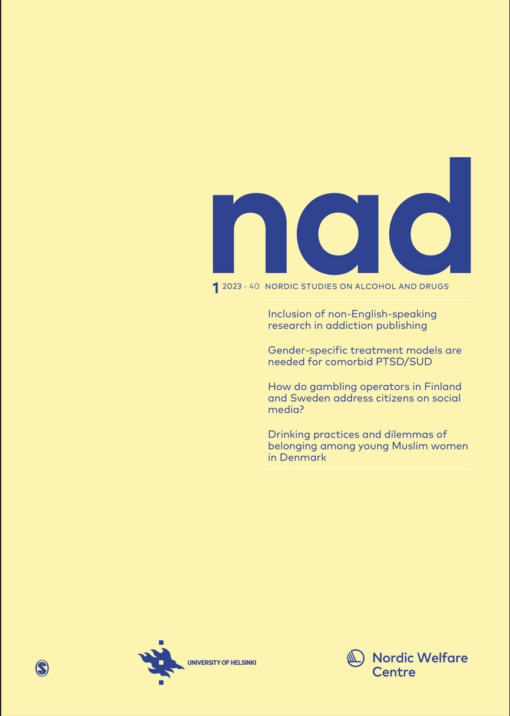
Read the latest issue of NAD here
Editorial
Matilda Hellman: The importance of debunking constructions
ISAJE position papers
Anees Bahji, Laura Acion, Anne-Marie Laslett & Bryon Adinoff: Exclusion of the non-English-speaking world from the scientific literature: Recommendations for change for addiction journals and publishers
Nady el-Guebaly, John Foster, Anees Bahji & Matilda Hellman: The critical role of peer reviewers: Challenges and future steps
Research reports
Marie Fjellerup Bærndt and Vibeke Asmussen Frank: Dilemmas of belonging: Young Muslim women in the Danish youth alcohol culture
Mikaela Lindeman, Vilja Männistö-Inkinen, Matilda Hellman, Veera Kankainen, Emmi Kauppila, Johan Svensson & Robin Nilsson: Gambling operators’ social media image creation in Finland and Sweden 2017–2020
Anna Belfrage, Anne Lill Mjølhus Njå, Siri Lunde, Janne Årstad, Elise Constance Fodstad, Torgeir Gilje Lid & Aleksander Hagen Erga: Traumatic experiences and PTSD symptoms in substance use disorder: A comparison of recovered versus current users
Christonikos Leventelis, Alexandra Katsouli, Vasileios Stavropoulos, Anna Karasavvidou, Panagiotis Papadopoulos, Petros T. Barmpas, Sotiris Tasoulis, Aristidis S. Veskoukis & Maria Tsironi: The development and validation of the pandemic medication-assisted treatment questionnaire for the assessment of pandemic crises impact on medication management and administration for patients with opioid use disorders
NAD 6/2022
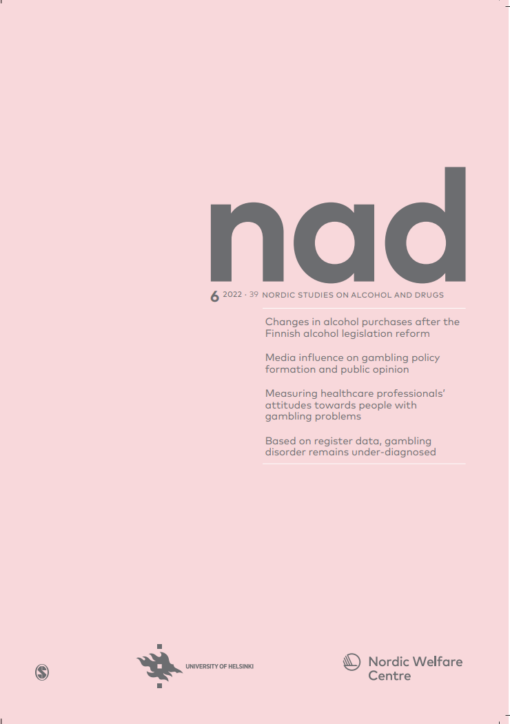
Read the latest issue of NAD here
Editorial
Matilda Hellman: Habits, consumption and public control
Research reports
Liisa Uusitalo, Jaakko Nevalainen, Ossi Rahkonen, Maijaliisa Erkkola, Hannu Saarijärvi, Mikael Fogelholm & Tomi Lintonen: Changes in alcohol purchases from grocery stores after authorising the sale of stronger beverages: The case of the Finnish alcohol legislation reform in 2018
Jani Selin & Riku Nyrhinen: Gambling policy positions of Finnish newspapers between 2004 and 2020: An automated content analysis
Anne H. Salonen, Sari Castrén, Tiina A. Latvala, Tanja Grönroos, Jonna Levola & Miika Vuori: Gender- and age-stratified analyses of gambling disorder in Finland between 2011 and 2020 based on administrative registers
Munenori Katayama, Keiji Kobara & Norihito Shirakawa: Gambling and Gambling Problem Perception Questionnaire as a tool to evaluate professionals’ attitudes towards problem gamblers and training programmes in Japan
NAD 5/2022
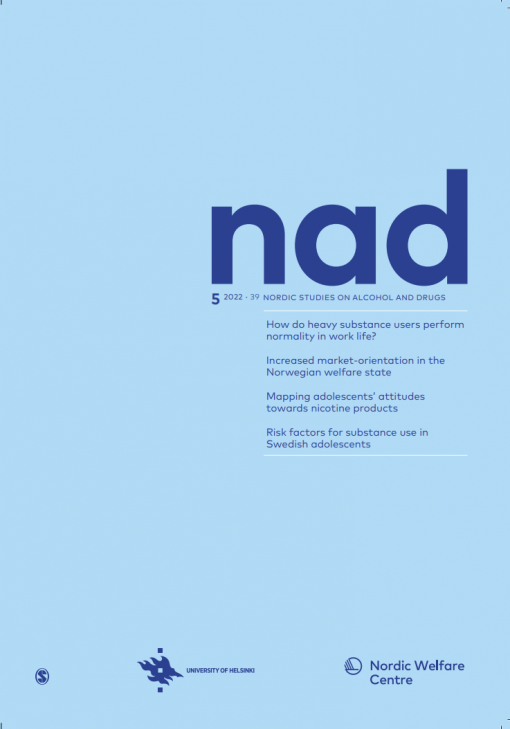
Read the latest issue of NAD here
Editorial
Matilda Hellman: Digital screens and children
Research reports
Malin Gunnarsson & Jukka Törrönen: Performing normality in working life among heavy
substance usersTord Skogedal Lindén & Rune Ervik: Health services in Nordic welfare states: Introducing a new category of providers through the Norwegian free treatment choice reform
Sindre Aske Høyland, Astrid Schuchert & Asgeir Mamen: A holistic perspective on continuing care for substance
use and dependence: Results and implications from an in-depth study of a Norwegian continuing care establishmentTord Finne Vedøy & Karl Erik Lund: The impact of the COVID-19 epidemic on where tobacco users purchased cigarettes and snus in different Norwegian regions
Nicklas Dennermalm, Patrik Karlsson & Mats Ekendahl: Risk factors for substance use in Swedish adolescents: A study across substances and time points
Stina Ingesson, Johan Ahlen, Nitya Jayaram-Lindström & Anders Hammarberg: Psychometric evaluation of a Swedish version of the Impaired Control Scale for individuals with alcohol use disorder
Review
Anu Vaihekoski, Hanna Lagström, Sini Eloranta, Susanna Bäärs, Annika Hannula, Mari Lehvikkö & Minna Salakari: Influencing adolescents’ attitudes towards nicotine products: A systematic reviewNAD 4/2022
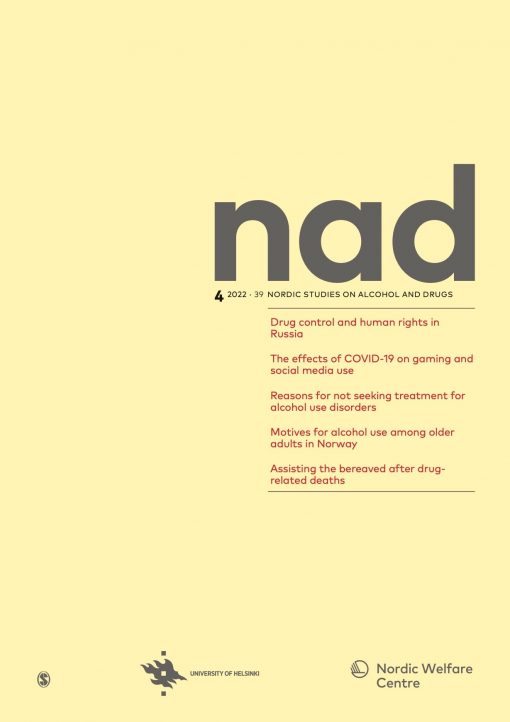
Read the latest issue of NAD here
Editorial
Matilda Hellman: Drug control and human rights in the Russian Federation
Research reports
Anders Nilsson, Ingvar Rosendahl and Nitya Jayaram-Lindström: Gaming and social media use among adolescents in the midst of the COVID-19 pandemic
André Syvertsen, Angelica B. Ortiz de Gortari, Daniel L. King and Ståle Pallesen: Problem mobile gaming: The role of mobile gaming habits, context, and platform
Lidia Santora, Don Byrne and Christian Klöckner: Clusters of older adults with and without experience of alcohol-related harms based on affective motivations for drinking
Tim Corney and Karin du Plessis: Australian first-year university college residents’ alcohol consumption and alcohol-related harms
Turid Wangensteen and Jacob Hystad: Trust and collaboration between patients and staff in SUD treatment: A qualitative study of patients’ reflections on inpatient SUD treatment four years after discharge
Kristine Tarp, Sengül Sari and Anette Sogaard Nielsen: Why treatment is not an option: Treatment naïve individuals, suffering from alcohol use disorders’ narratives about alcohol use and treatment seeking
Review
Monika Alvestad Reime, Hilde-Margit Løseth, Sari Kaarina Lindeman, Kristine Berg Titlestad, Kari Dyregrov and Lillian Bruland Selseng: Professional helpers’ experiences of assisting the bereaved after drug-related deaths: A knowledge gap
NAD 3/2022
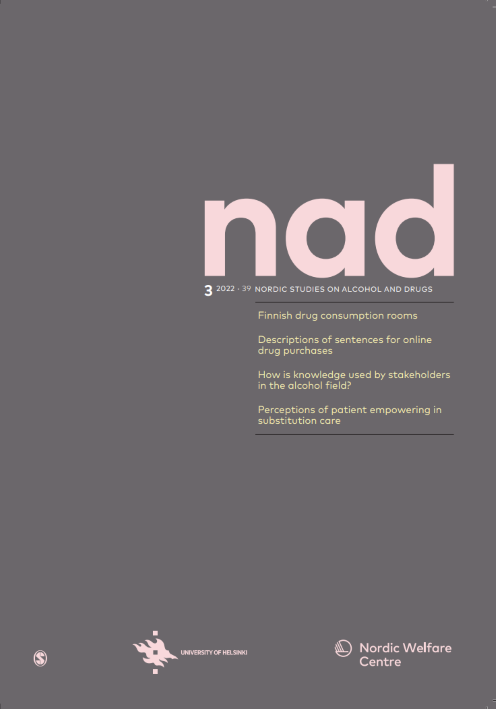
Read the latest issue of NAD here
Research reports
Ali Unlu, Tuukka Tammi and Pekka Hakkarainen: Policy windows for drug consumption rooms in Finland
Fredrik Tiberg and Johan Nordgren: Ordinary people, criminals, addicts and recreational users: Swedish court of law descriptions of persons sentenced for online drug purchases
Katarina Winter and Johan Edman: Förnuft och känsla – Kunskapsbruk hos gårdagens förbudskritiker och dagens alkoholliberaler
Linda Nesse, Marianne Thorsen Gonzalez, Michael Rowe and Ruth Kjærsti Raanaas: Citizenship matters: Translating and adapting the Citizenship Measure to Norwegian
Lisa Andersson: A transition of power in opioid substitution treatment: Clinic managers’ views on the consequences of a patient choice reform
Susan Calnan and Martin P. Davoren: College students’ perspectives on an alcohol prevention programme and student drinking – A focus group study
Adriana del Palacio-Gonzalez and Mads Uffe Pedersen: Youth’s personal relationships, psychological symptoms, and the use of different substances: A population-based study
Obituary
Thomas Karlsson, Mikaela Lindeman, Pia Mäkelä, Jussi Simpura and Christoffer Tigerstedt: Esa Österberg (22 June 1948 – 26 September 2021)
NAD 1/2022
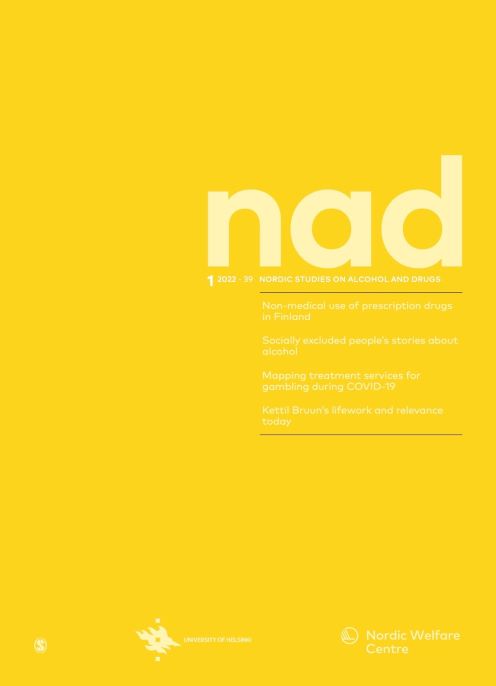
Read the latest issue of NAD here
Editorial
Matilda Hellman: Justice and equality as a zero-sum gameFor Debate
Matilda Hellman: Kettil Bruun is more relevant than everResearch Reports
Virve Marionneau and Johanna Järvinen-Tassopoulos: Treatment and help services for gambling during COVID-19: Experiences of gamblers and their concerned significant othersPol Rovira, Gražina Belian, Carina Ferreira-Borges, Carolin Kilian, Maria Neufeld, Alexander Tran, Mindaugas Štelemė kas and Jürgen Rehm: Alcohol taxation, alcohol consumption and cancers in Lithuania: A case study
Elin K. Bye, Stig Tore Bogstrand and Ingeborg Rossow: The importance of alcohol in elderly’s hospital admissions for fall injuries: a population case-control study
Minna Pylväs-Korolainen, Karoliina Karjalainen and Tomi Lintonen: Factors associated with non-medical use of prescription drugs among individuals with a legitimate prescription for medical purposes: A population-based study
Ilona Piispa, Karoliina Karjalainen and Niina Karttunen: Nonmedical use of prescription drugs: A comparison between intoxicationoriented and other nonmedical users
Line Lund Eriksen and Bente Hoeck: The construction of meaning in alcohol addiction: A narrative study of socially excluded people’s stories about alcohol
Rikke Hellum, Randi Bilberg and Anette Søgaard Nielsen: “He is lovely and awful”: The challenges of being close to an individual with alcohol problems
Jóna Ólafsdóttir and Sindri Steinn Marinósson: Childhood with a relative’s excessive alcohol use, and own drinking in adult years
NAD 6/2021
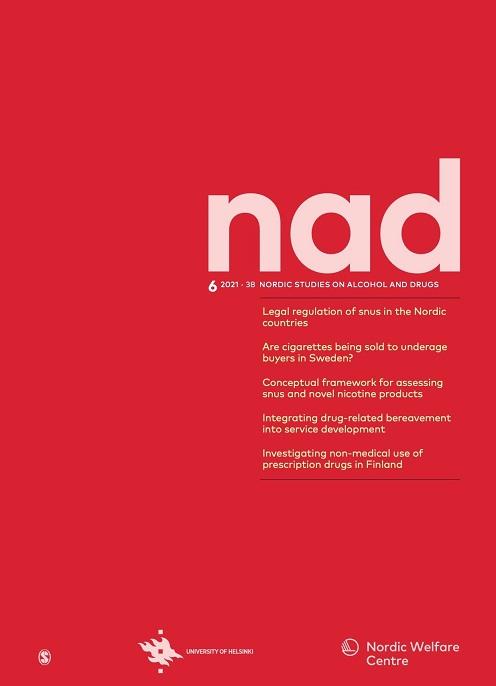
Read the latest issue of NAD here
Editorial:
Messages from research: Tobacco, drug use, gambling
Matilda HellmanResearch Reports:
Snus and snus-like nicotine products moving across Nordic borders: Can laws protect young people?
Marjut Salokannel, Eeva OllilaWho are the young users of tobacco products? Prevalence and characteristics of Danish adolescents who have either smoked cigarettes, used alternative tobacco products, or used both
Simone Gad Kjeld, Susan Andersen, Anette Andersen, Stine Glenstrup, Lisbeth Lund, Dina Danielsen, Lotus Sofie BastSales of cigarettes to pseudo-underage mystery shoppers: Experiences from Stockholm County
Kristin Feltmann, Johanna Gripenberg and Tobias H. ElgánA conceptual framework for assessing the public health effects from snus and novel non-combustible nicotine products
Karl Erik Lund and Tord Finne VedøySmoking, hazardous drinking and individual differences in cost and gain discounting
Torleif HalkjelsvikAdvice to policy-makers for improving services to the drug-death bereaved
Svanaug Fjær and Kari DyregrovFor Debate:
Gambling harms caused by electronic gambling machines should be prevented with state control
Johanna Järvinen-Tassopoulos, Virve Marionneau and Janne NikkinenBook Review:
Vicious games: Gambling and capitalism
Janne NikkinenNAD 2/2021
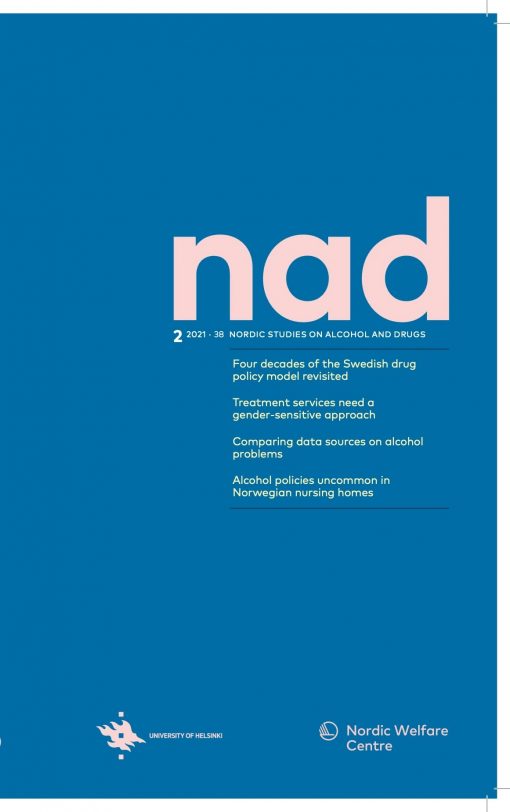
This issue includes the following themes
Revisiting some concepts and events in Sweden’s prohibitionist drug policy model, substance use among young people in Norway who smoke and use snus, the praxis of interprofessional team meetings tailored to the needs of people with substance use disorders, and the experiences of health professionals in Norwegian nursing homes in terms of residents’ alcohol consumption
Dealing with qualitative work
Matilda HellmanA path forward for Swedish drug policy?
Ted GoldbergComparison of data sources on alcohol problems: An exploratory exercise using surveys vs. national healthcare registers
Pia Mäkelä, Kristiina Kuussaari, Airi Partanen and Elina RautiainenSmoking and snus use among Norwegian students: Demographic, personality and substance use characteristics
Solbjørg Makalani Myrtveit Sæther, Kristin Gärtner Askeland, Ståle Pallesen and Eilin Kristine ErevikHealth professionals’ experience of nursing home residents’ consumption of alcohol and use of psychotropic drugs
Aud Johannessen, Kjerstin Tevik, Knut Engedal and Anne-Sofie HelvikWomen’s views on barriers and facilitators for seeking alcohol and drug treatment in Belgium
Julie Schamp, Sarah Simonis, Griet Roets, Tina Van Havere, Lies Gremeaux and Wouter VanderplasschenUser involvement in interprofessional team meetings within services for substance use disorders
Merethe Wenaas, Helle Wessel Andersson, Riina Kiik and Anne JubergNAD 1/2021
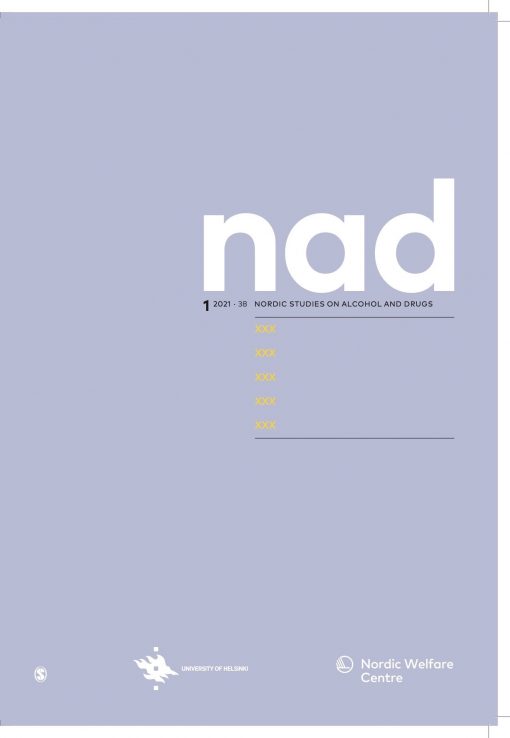
This issue includes the following themes
The meanings of the terms alcoholism, alcohol dependence, alcohol misuse and risky drinking, the possibility of drinkers switching to other substances in response to any rise in the cost of alcohol, methodological challenges for research in psychedelics use and its consequences, and Sweden’s long, complicated harm reduction policy transition
The constitution of the alcoholic self, communicative processes and administrative practices: On the varied uses of four terms denoting problematic drinking
Filip Roumeliotis, Frida Carlsson, Linn Johansson Erkenfelt, Lisa WallanderAdapting existing behaviour: Perceptions of substance switching and implementation of minimum pricing for alcohol in Wales
Wulf Livingston, Katy Holloway, Tom May, Marian Buhociu, Iolo Madoc-Jones, Andy PerkinsWho is the typical psychedelics user? Methodological challenges for research in psychedelics use and its consequences
Petter Grahl JohnstadKnowledge, attitudes and practice of self-medication among university students in Portugal: A cross-sectional study
Regina Ferreira Alves, José Precioso, Elisardo BecoñaCould 30 years of political controversy on needle exchange programmes in Sweden contribute to scaling-up harm reduction services in the world?
Niklas Karlsson, Torsten Berglund, Anna Mia Ekström, Anders Hammarberg, Tuukka TammiEcstasy (MDMA): A rebellion coherent with the system
José Manuel García-Montes, Marino Pérez-Álvarez, Miguel Ángel Sánchez-Moya, José Alberto Carmona Torres, David F. Carreno, Salvador Perona Garcelán, Laura del Carmen Sánchez-SánchezNAD 6/2020
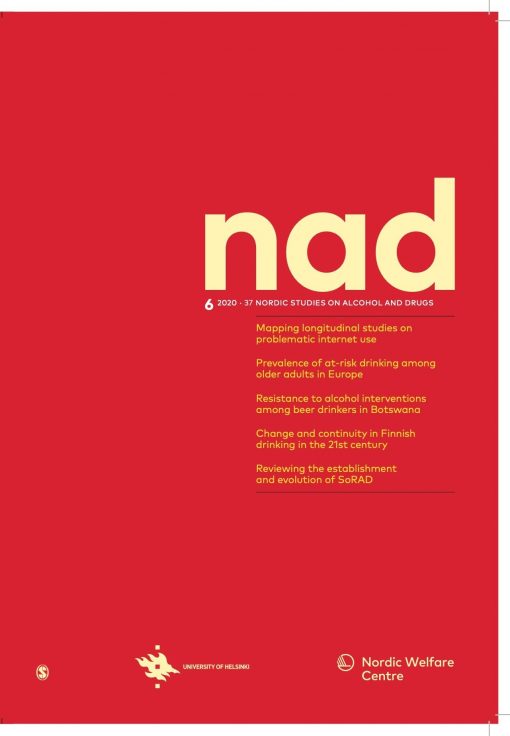
This issue includes the following themes
Alcohol drinking, studied from many perspectives and by different methodologies
Mental health work cannot be postponed
Matilda HellmanProblematic internet use: A scoping review – longitudinal research on a contemporary
social problem, 2006–2017
Daniel Dahl and Karin Helmersson BergmarkAlcohol use among older adults: A comparative study across four European countries
Ingeborg Rossow and Bente TræenBeer drinking, resistance and the politics of alcohol tax levy in Botswana
Tebogo B SebeeloObservational learning of the televised consequences of drinking alcohol: Exploring the role of perceived similarity
Mira Mayrhofer and Jörg MatthesParents’ experiences of substance use problems, parenthood, and recovery within the 12-step movement
Karin Heimdahl VepsäThe new suit of the Centre for Social Research on Alcohol and Drugs (SoRAD): A well-tailored costume for tackling research and challenges ahead
Jessica Storbjörk, Jonas Landberg and Robin RoomChange and continuity in Finnish drinking in the 21st century
Christoffer Tigerstedt, Pia Mäkelä, Thomas Karlsson, Janne Härkönen, Tomi Lintonen and Katariina WarpeniusThe Finnish Drinking Habits Survey: Implications for alcohol policy and prevention
Katariina Warpenius and Pia MäkeläNAD5/2020
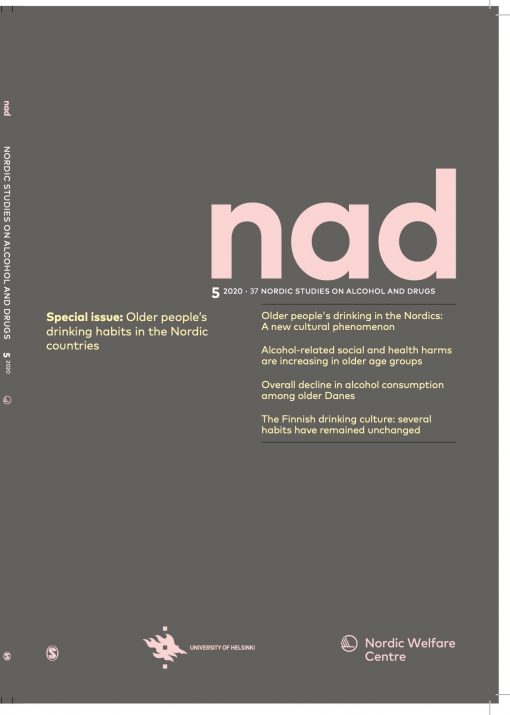
This issue includes the following themes
Older people’s drinking habits in the Nordic countries, describing the status of and examining trends in older people’s drinking patterns in recent decades
Who initiates Nordic comparisons?
Matilda Hellman
Introduction to the special section on drinking patterns in older age
Christoffer Tigerstedt and Kim Bloomfield
Comparing older people’s drinking habits in four Nordic countries: Summary of the thematic issue
Christoffer Tigerstedt, Neda Agahi, Elin K Bye, Ola Ekholm, Janne Härkönen, Heidi Rosendahl Jensen, Cathrine Juel Lau, Pia Mäkelä, Inger Synnøve Moan, Suvi Parikka, Jonas Raninen, Anni Vilkko and Kim Bloomfield
Trends in older adults’ alcohol use in Norway 1985–2019
Elin K Bye and Inger Synnøve Moan
Trends in older people’s drinking habits, Sweden 2004–2017
Jonas Raninen and Neda Agahi
Drinking patterns among Finns aged 60 years and over from the 1990s onwards
Christoffer Tigerstedt, Janne Härkönen, Pia Mäkelä, Suvi Parikka and Anni Vilkko
Trends in alcohol consumption among older adults in Denmark in the 21st century
Heidi Amalie Rosendahl Jensen, Kim Bloomfield, Cathrine Juel Lau and Ola Ekholm
NAD 4/2020 (August)
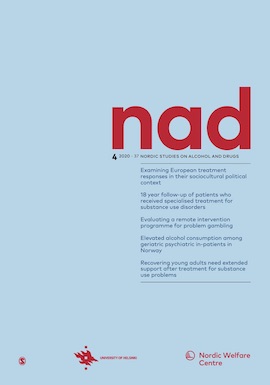
This issue includes the following themes
Successes and failures in drug treatment from a European perspective, follow-ups of treatment interventions in Norway and Sweden, and the wellbeing of patients,
Editorial
The new project of public health
Matilda HellmanResearch reports
Successes and failures in treatment of substance abuse: Treatment system perspectives and lessons from the European continent
Harald KlingemannRecovery processes among young adults treated for alcohol and other drug problems: A five-year follow-up
Lisa Skogens and Ninive von GreiffLevels of mental distress over 18 years after entering treatment for substance use disorders: A longitudinal cohort study
Arne Jan Hjemsæter, Jørgen G Bramness, Robert Drake, Ivar Skeie, Bent Monsbakken, Jūratė Šaltytė Benth and Anne S LandheimThe Norwegian remote intervention programme for problem gambling: Short- and long-term outcomes
Eilin K Erevik, Ståle Pallesen, Mette Mohn, Trond Aspeland, Øystein Vedaa, Torbjørn TorsheimChanges in clients’ well-being (ORS) and state hope (SHS) during inpatient substance abuse treatment
Eeva Ekqvist and Katja KuusistoElevated alcohol consumption among geriatric psychiatric in-patients
Anne-Sofie Helvik, Knut Engedal and Aud JohannessenReliability and construct validity of five life domains in the adolescent drug abuse diagnosis instrument in a sample of Swedish adolescent girls in special residential care
Marie-Louise Klingstedt, Margit Wångby-Lundh, Tina Olsson and Laura Ferrer-WrederNAD 3/2020 (June)
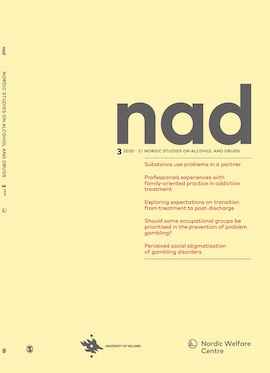
This issue includes the following themes
Substance use problems in a partner, professionals experiences with family-oriented practice in addiction treatment, exploring expectations on transition from treatment to post-discharge, should some occupational groups be prioritised in the prevention of problem gambling?, perceived social stigmatisation of gambling disorders
Editorial
Who is an expert on the COVID-19 crisis?
Matilda HellmanResearch reports
Substance use disorder patients’ expectations on transition from treatment to post-discharge period
Dagny Adriaenssen Johannessen, Trond Nordfjærn and Amy Østertun Geirdal“It’s like being stuck on an unsafe and unpredictable rollercoaster”: Experiencing substance use problems in a partner
Bente M Weimand, Bente Birkeland, Torleif Ruud and Magnhild M Høie“Jeg fa˚r et helt annet innblikk”: Fagpersoners erfaringer med familieorientert praksis i rusbehandling
Øyvind Reehorst Kalsa˚s, Anne Schanche Selbekk and Ottar NessRisk of problem gambling among occupational groups: A population and registry study
Per Binde and Ulla RomildPerceived social stigmatisation of gambling disorders and coping with stigma
Katarzyna Dabrowska and Łukasz WieczorekOverview Opioid maintenance treatment of pregnant women in the Scandinavian countries
Marte Handal, Svetlana Skurtveit, Milada Mahic, Inger Øhman, Birgitta Norstedt Wikner, Christian Tjagvad, Helle Kieler, Erja Halmesmäki and Ingunn Olea LundBook review
Regulating cannabis: A detailed scenario for a nonprofit cannabis market, by Tom Decorte
Tuulia LerkkanenNAD 2/2020 (April)
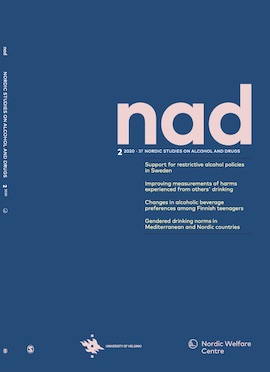
This issue includes the following themes
Support for restrictive alcohol policies in Sweden, improving measurements of harms experienced from others’ drinking, changes in alcoholic beverage preferences among Finnish teenagers, gendered drinking norms in Mediterranean and Nordic countries
Editorial
Concepts and conditions for knowledge production
Matilda HellmanResearch reports
Solidarity or self-interest? Public opinion in relation to alcohol policies in Sweden
David Karlsson, Sören Holmberg and Lennart WeibullImproving measurement of harms from others’ drinking: A key informant study on type and severity of harm
Oliver Stanesby, Gerhard Gmel, Kathryn Graham, Thomas K Greenfield, Orratai Waleewong and Sharon C WilsnackAlcoholic beverage preferences among teenagers in Finland before and after the 2018 alcohol law change
Tomi Lintonen, Suvi Ahtinen and Anne KonuMaternal alcohol intakes before and during pregnancy: Impact on the mother and infant outcome to 18 months
Barry William McDonald and Patricia Ellyett WatsonThe gendered relationship with drunkenness among different generations in Mediterranean and Nordic countries
Sara Rolando, Jukka To¨rro¨nen and Franca BeccariaHomeless people under the influence of alcohol admitted to hospital emergency departments in Poland
Anna Burak, Katarzyna Cierzniakowska and Aleksandra PopowCommentary
Opinions on alcohol policy in Sweden
Thomas KarlssonNAD 1/2020 (February)
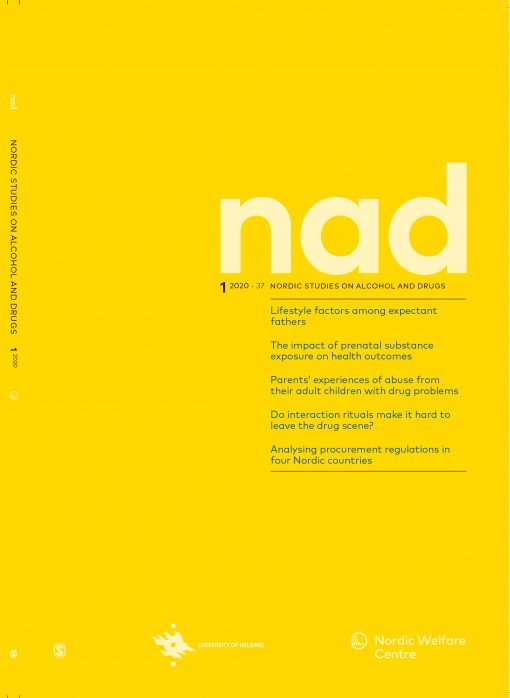
This issue includes the following themes
Procurement regulations in four Nordic countries, lifestyle factors among expectant fathers, the impact of prenatal substance exposure on health outcomes, parents’ experiences of abuse from their adult children with drug problems, interaction rituals in a drug scene
Public funding of science publishing: Why we are open access
Matilda Hellman
Anne M Koponen, Niina-Maria Nissinen, Mika Gissler, Taisto Sarkola, Ilona Autti-Rämö, Hanna Kahila
Kerstin Stenius, Jessica Storbjörk
Associations between a risky psychosocial childhood and recurrent addiction compulsory care as adult
Robert Grahn, Mojgan Padyab, Lena Lundgren
Interaction rituals in an open drug scene
Trond E Grønnestad, Hildegunn Sagvaag, Philip Lalander
Pre conception use of cannabis and cocaine among men with pregnant partners
Elisabeth Lobben Munch, Svetlana Skurtveit, Marte Handal, Eva Skovlund
Parents’ experiences of abuse by their adult children with drug problems
Bengt Svensson, Torkel Richert, Björn Johnson
NAD/2019 (December)
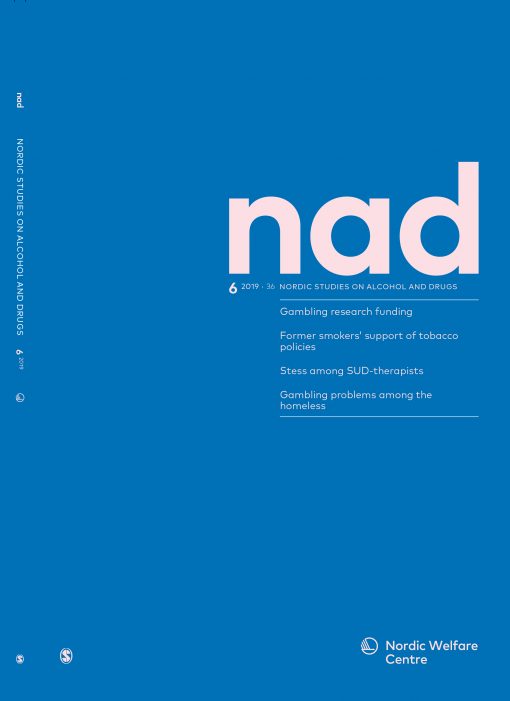
Can gambling-funded research be non-biased? The case of section 52
Matilda Hellman
Funding of gambling studies and its impact on research
Janne Nikkinen
In favour of tobacco control? Former smokers’ support for tobacco policies
Tove Sohlberg
Jakob Emiliussen, Kjeld Andersen, Anette Søgaard Nielsen, Barbara Braun, Randi Bilberg
Secondary traumatic stress in Norwegian SUD-therapists: Symptoms and related factors
Ayna B Johansen, Eva Kristiansen, Ingerid Bjelland, Shedeh Tavakoli
Christophe Soussan, Anette Kjellgren
Screening of problem gambling among a homeless population in Warsaw
Łukasz Wieczorek, Jakub Stokwiszewski, Justyna I Klingemann
Alcohol industry strategies to influence the reform of the Finnish Alcohol Law
Thomas Babila Sama, Heikki Hiilamo
NAD 5/2019 (October)
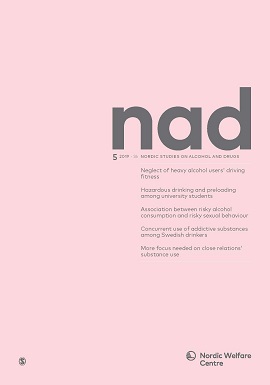
Comorbidity and concurrence of problems: Overlooked, not under-researched
Matilda Hellman
Mats Ramstedt
Self-reported harm from others’ alcohol, cigarette and illegal drug use in Norway
Inger Synnøve Moan, Elin K Bye, Elisabet E Storvoll, Ingunn Olea Lund
Breath alcohol concentration, hazardous drinking and preloading among Swedish university students
Tobias H Elgàn, Natalie Durbeej, Johanna Gripenberg
Anna Strandberg, Charlotte Skoglund, Johanna Gripenberg, Pia Kvillemo
Juhani Kalsi, Markku Tervo, Timo Tervo
Fatal attraction: A narrative of early opioid addiction
Willy Pedersen
NAD 4/2019 (August)
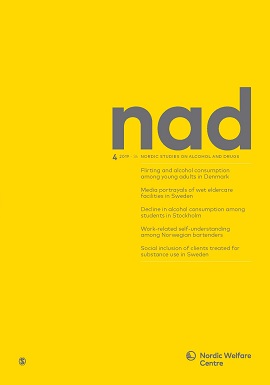
Matilda Hellman
Social inclusion of clients treated for substance abuse in Sweden in the 1980s: A 27-year follow-up
Ninive von Greiff, Lisa Skogens, Marie Berlin
Out of the ordinary: Media reports on wet eldercare facilities
Håkan Jönson, Tove Harnett
Declining alcohol consumption among adolescents and schools in Stockholm, 2010–2016
Per Carlson
Playing with gender borders: Flirting and alcohol consumption among young adults in Denmark
Mie Birk Jensen, Maria Dich Herold, Vibeke Asmussen Frank, Geoffrey Hunt
“Gjesten har aldri rett” – Bartendere på hippe utesteders forståelse av yrket
Skule Wigenstad
Johan Edman
NAD 3/2019 (June)
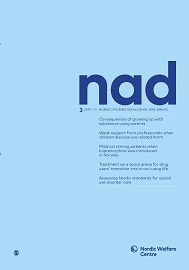
A window of opportunity for children growing up with parental substance-use problems
Anne Schanche Selbekk
Disclosure of alcohol-related harm: Children’s experiences
Ilona Tamutienė, Birutė Jogaitė
Eva Tedgård, Maria Råstam, Ingegerd Wirtberg
Into the unknown: Treatment as a social arena for drug users’ transition into a non-using life
Inger Eide Robertson, Sverre Martin Nesvåg
Aleksandra Bartoszko
Standards for opioid use disorder care: An assessment of Nordic approaches
Charlotte Gedeon, Mikael Sandell, Inge Birkemose, Johan Kakko, Valgerður Rúnarsdóttir, Kaarlo Simojoki, Thomas Clausen, Fred Nyberg, Richard Littlewood, Hannu Alho
Childhood narratives about the experience of growing up with alcoholic parents
Anneli Silvén Hagström
When children with substance-abusing parents grow up and become parents themselves: A commentary
Elisabet Näsman
Professionals do not invite children to disclose family problems: A comment
Elisabet Näsman
NAD 2/2019 (April)
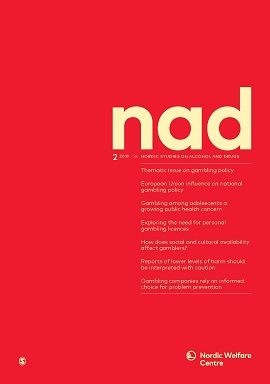
Gambling – no ordinary commodity
Matilda Hellman
Ingeborg Rossow
National gambling policies and the containment of the EU’s politico-legal influence
Jani Selin
David Forsström, Jenny Cisneros Örnberg
Is there a need for personal gambling licences?
Janne Nikkinen
Cultures and spaces of convenience gambling
Michael Egerer, Virve Marionneau
Eva Samuelsson, Peter Wennberg, Kristina Sundqvist
Gambling patterns and associated risk and protective factors among Finnish young people
Atte Oksanen, Anu Sirola, Iina Savolainen, Markus Kaakinen
Gambling among Swedish youth: Predictors and prevalence among 15- and 17-year-old students
Johan Svensson, Kristina Sundqvist
Tiina Latvala, Hannu Alho, Susanna Raisamo, Anne H Salonen
NAD 1/2019 (February)
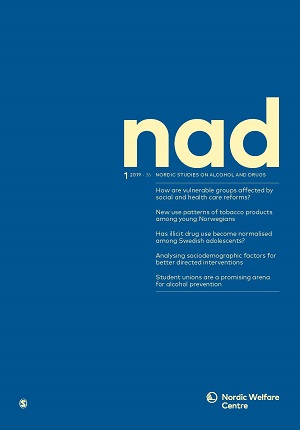
Social and healthcare reforms and vulnerable groups
Matilda Hellman
Camilla Stub Lundberg, Elisabeth Kvaavik, Rikke Tokle
Patrik Karlsson, Mats Ekendahl, Josefin Månsson, Jonas Raninen
Ljubica Pakovic, Jovana Todorovic, Milena Santric-Milicevic, Dragica Bukumiric, Zorica Terzic-Supic
Alcohol policies and attitudes toward alcohol prevention at Swedish student unions
Anna K. Strandberg, Tobias H. Elgán, Magnus Jägerskog, Johanna Gripenberg
NAD 6/2018 (December)
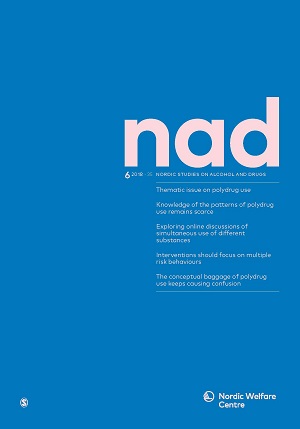
More social research into polydrug use
Kati Kataja, Christoffer Tigerstedt, Pekka Hakkarainen
Poly and Tricky Dick: The drug war origins of the term “polydrug use”
Axel Klein
A virtual academy of polydrug use: Masters, novices and the art of combinations
Kati Kataja, Jukka Törrönen, Pekka Hakkarainen, Christoffer Tigerstedt
Katherine J. Karriker-Jaffe, Meenakshi S. Subbaraman, Thomas K. Greenfield, William C. Kerr
Comment on Karriker-Jaffe et al.
Karoliina Karjalainen
Book review: Studying recreational polydrug use through an ontology agent-based simulation
Jenni Savonen
NAD 5/2018 (October)
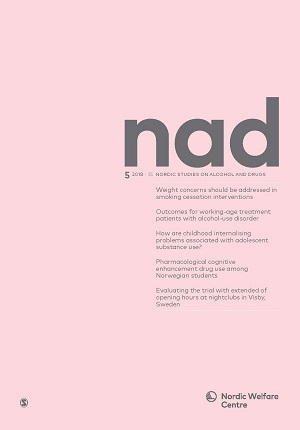
Opioids, opioids, opioids: The plague among middle-aged white Americans
Matilda Hellman
Elina Rautiainen, Olli-Pekka Ryynänen, Tiina Laatikainen
Eeva-Liisa Tuovinen, Suoma E. Saarni, Taru H. Kinnunen, Hanna Ollila, Otto Ruokolainen,Kristiina Patja, Satu Männistö, Pekka Jousilahti, Jaakko Kaprio, Tellervo Korhonen
Ove Heradstveit, Jens Christoffer Skogen, Tormod Bøe, Jørn Hetland, Mads Uffe Pedersen, Mari Hysing
Helga Myrseth, Ståle Pallesen, Torbjørn Torsheim, Eilin Kristine Erevik
Extended opening hours at nightclubs in Visby: An evaluation of a trial in the summer of 2014
Thor Norström, Mats Ramstedt, Johan Svensson
NAD 4/2018 (August)
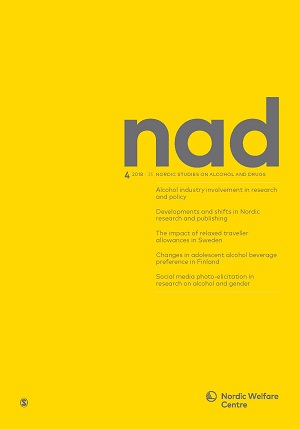
The alcohol industry’s never-ending interest in research and policy
Matilda Hellman
Governance of substance use as a by-product of policing in Norway: A historical account
Kenneth Arctander Johansen, Virginie Debaere, Stijn Vandevelde, Michel Vandenbroeck
Lena Eriksson, Johan Edman
Martin Stafström
Social media platforms as a photo-elicitation tool in research on alcohol intoxication and gender
Ryan Laws, Geoffrey Hunt, Tamar M. J. Antin
Changes in Finnish adolescents’ alcoholic beverage preferences 1999–2017
Tomi Lintonen, Suvi Ahtinen, Anne Konu
Kerstin Stenius looks back at developments in Nordic research and publishing
Matilda Wrede-Jäntti
NAD 3/2018 (June)
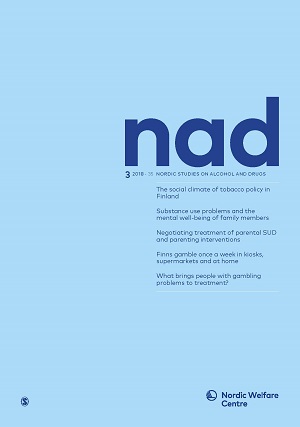
Social causes of depression, anxiety and stress
Matilda Hellman
Otto Ruokolainen, Hanna Ollila, Kristiina Patja, Katja Borodulin, Tiina Laatikainen, Tellervo Korhonen
Depression, anxiety, and stress from substance-use disorder among family members in Iceland
Jóna Ólafsdóttir, Steinunn Hrafnsdóttir, Tarja Orjasniemi
Eli Marie Wiig, Astrid Halsa, Jørgen Bramness, Siv Merete Myra, Bente Storm Mowatt Haugland
What makes people with gambling disorder undergo treatment? Patient and professional perspectives
Łukasz Wieczorek, Katarzyna Dąbrowska
Anne H. Salonen, Matilda Hellman, Tiina Latvala, Sari Castrén
NAD 2/2018 (April)
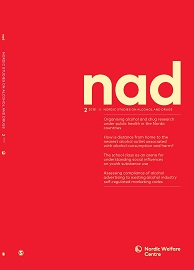
Should we watch out for the giant isomorphic wheel of public health?
Matilda Hellman
The population, its health and social sciences
Sophy Bergenheim
The two sides of public health
Pekka Sulkunen
Framing drug and alcohol use as a public health problem in Britain: Past and present
Alex Mold
Public health is not an innocent concept
Kerstin Stenius
Robin Room
Reliability and validity of the Alcohol Marketing Assessment Rating Tool (AMART)
Jonathan K. Noel, Thomas F. Babor, Katherine Robaina
Abdu K. Seid, Gabriele Berg-Beckhoff, Christiane Stock, Kim Bloomfield
Individual and school-class correlates of youth cannabis use in Sweden: A multilevel study
Patrik Karlsson, Mats Ekendahl, Isabella Gripe, Jonas Raninen
NAD 1/2018 (February)
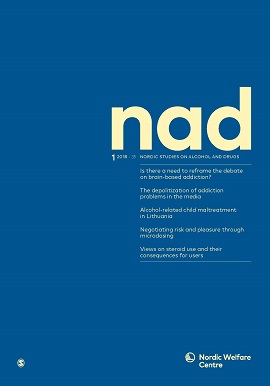
This issue of NAD deals with microdosing, alcohol-related maltreatment, gender differences among adolescents with substance abuse problems, media depictions of addiction problems, and the health service needs of users of anabolic androgenic steroids.
Alcohol-related maltreatment in child protection
Knowledge of the extent of alcohol-related maltreatment of children in Lithuania is limited. The study was based on a content analysis of child protection documents. More than one person with problematic alcohol consumption was identified in over a third of cases. Most often, it was the police (26.6%) or a close relative (16.3) who alerted the child welfare authorities about maltreatment.
Gender differences among young people with substance abuse problems
What are the similarities and differences in risk factors between boys and girls with addiction problems when they get into outpatient care? The study was based on interview data from 2169 youths over a three-year period from clinics in eleven Swedish cities. Girls came from more difficult family and childhood environments. They also had more likely problems at school, more difficult drug addiction and more serious mental health problems, while boys had much higher crime activity.
Psychedelic substances in tiny amounts
Micro dosing of psychedelic drugs is not about intoxication but about increased everyday function. The dosage is often about one tenth of the usual recreational dose. The 21 men in the thirties who participated in the interview study reported mainly positive experiences regarding mood, cognition and creativity.
Which voices are heard in media?
By analysing articles about addiction problems in daily newspapers in Poland, Italy and Finland, the study points to how reporting trends have changed since the early 1990s. More and more space is given to individuals with addiction problems and to researchers who represent a biomedical approach.
What do users of anabolic androgenic steroids want from health services?
The use of anabolic androgenic steroids can lead to increased muscle mass and strength, but also to unwanted side effects. In Norway, the specialized substance abuse treatment services are responsible for assisting users of anabolic androgenic steroids with health problems. The study points to how healthcare can become more accessible to this group. [The study is published in Norwegian but has an English language abstract]
NAD 6/2017 (December)

Drinking with parents: Different measures, different associations with underage heavy drinking?
Hilde Pape, Elin K. Bye
Parent participation in alcohol prevention: Evaluation of an alcohol prevention programme
Frode Adolfsen, Henriette Kyrrestad Strøm, Monica Martinussen, Bjørn Helge Handegård, Henrik Natvig, Martin Eisemann, Roman Koposov
Otto Ruokolainen, Hanna Ollila, Karoliina Karjalainen
Gunnar Sæbø, Janne Scheffels, Rikke Tokle
Recurrent cannabis use among Norwegian students: Prevalence, characteristics, and polysubstance use
Eilin K. Erevik, Torbjørn Torsheim, Cecilie S. Andreassen, Øystein Vedaa, Ståle Pallesen
NAD 5/2017 (October)
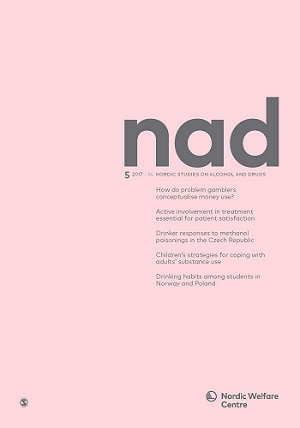
Agency as a structuring principle
Matilda Hellman
Is it all about money? A qualitative analysis of problem gamblers’ conceptualisations of money
Maria Heiskanen
Patient satisfaction with treatments and outcomes in residential addiction institutions
Helle Wessel Andersson, Eli Otterholt, Rolf W. Gråwe
Vendula Belackova, Barbara Janikova, Jaroslav Vacek, Hana Fidesova, Michal Miovsky
Barns upplevelser när föräldrars missbruk upphört: “Alltså det är svårt att må bra igen”
Karin Alexanderson, Elisabet Näsman
Eilin K. Erevik, Ståle Pallesen, Øystein Vedaa, Cecilie S. Andreassen, Torbjørn Torsheim
Robert Podstawski, Elżbieta Wesołowska, Dariusz Choszcz
NAD 4/2017 (August)
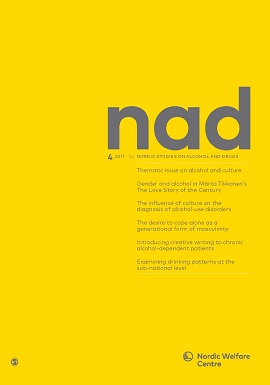
Alcohol and culture: An introduction
Anette Søgaard Nielsen, Anne-Marie Mai
Märta Tikkanen’s gender and alcohol saga
Anne-Marie Mai
Rikke Hellum, Stine Jensen, Anette Nielsen
Alcohol use and generational masculinity: An interdisciplinary approach
Jakob Emiliussen, Alastair David Morrison
Jürgen Rehm, Robin Room
Kim Bloomfield, Ulrike Grittner, Ludwig Kraus, Daniela Piontek
Pekka Sulkunen
NAD 3/2017 (June)
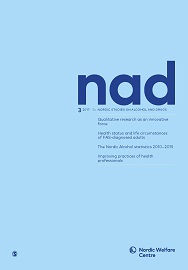
Exploring new substance use settings
Matilda Hellman
Scientific progress: The role of innovative qualitative inquiries
Matilda Hellman
A qualitative analysis of Pål Kraft
Johan Edman
The endless dilemma with qualitative research
Johanna Järvinen-Tassopoulos
Risky consumption of alcohol and drugs among employees at ski resorts
Maria Warne, Kristina Sinadinovic, Anne H Berman, Håkan Källmén, Stig Vinberg
Martin Andersson, Anette Kjellgren
Mette Grønkjær, Lise Nørregaard Søndergaard, Mona Østergaard Klit, Kerstin Mariegaard, Kathrine Hoffmann Kusk
Aud Johannessen, Knut Engedal, Anne-Sofie Helvik
Jenny Rangmar, Annika Dahlgren Sandberg, Marita Aronson, Claudia Fahlke
Nordic alcohol statistics 2010–2015
Matilda Hellman, Tom Kettunen
NAD 2/2017 (April)
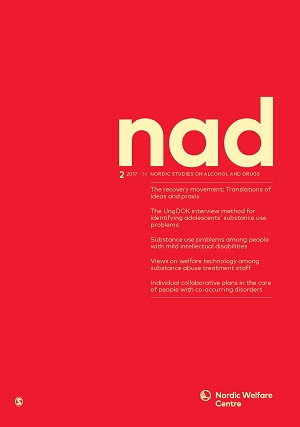
Thirty-three years later: Still a new-old journal
Matilda HellmanThe recovery movement and its implications for policy, commissioning and practice
David Best, Stephanie Judith De Alwis, Donna BurdettIs it possible to recover from recovery?
Liese ReckeCan Nordic alcohol and drug treatment benefit from a recovery perspective?
Kerstin SteniusCollaboration between community social services and healthcare institutions: The use of a collaborative individual plan
Håkan Källmén, Anders Hed, Tobias H. ElgánEmployees’ attitudes towards welfare technology in substance abuse treatment in Finland
Teemu Rantanen, Timo ToikkoPatterns of polydrug use among pregnant substance abusers
Therese ReitanPsychometric properties of the UngDOK: A structured interview for adolescents with substance-use problems
Mikael Dahlberg, Mats Anderberg, Peter WennbergSubstance use problems among people with mild/borderline intellectual disability: Challenges to mainstream multidisciplinary specialist substance treatment in Norway
Anne Juberg, Monica Røstad, Erik SøndenaaNAD 1/2017 (February)
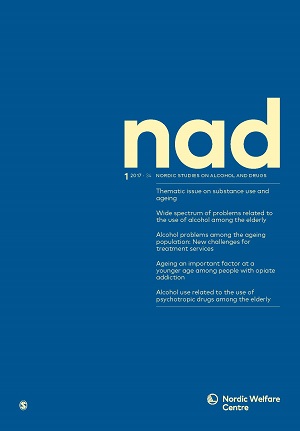
Thematic issue on substance use and ageing
Thematic issue: Substance use and ageing
Sverre Nesvåg
Magdalena Bergström
Concomitant alcohol and sedative-hypnotic drug use among the elderly in Norway
Elin Kristin Bye, Ingeborg Rossow
Jakob Emiliussen, Kjeld Andersen, Anette S. Nielsen
Evy Gunnarsson, Lis-Bodil Karlsson
Aud Johannesen, Knut Engedal, Marianne Larsen, Elin Lillehovde, Line Tegner Stelander, Anne-Sofie Helvik
Hege Tollefsen Nyhagen, Helge Waal
Health and social issues among older patients in opioid maintenance treatment in Norway
Zhanna Gaulen, Silvia Eiken Alpers, Siv-Elin Leirvåg Carlsen, Sverre Nesvåg
Ole Næss, Sverre Nesvåg
Aldring og skadelige rusmiddelvaner – muligheter og utfordringer
Ingjerd Woldstad
NAD 5-6/2016 (December)
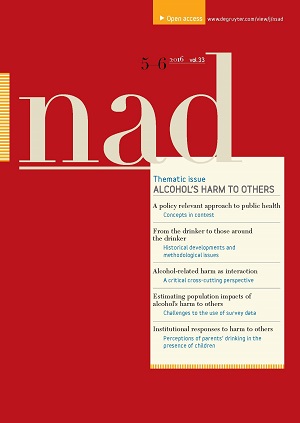
Thematic issue on alcohol's harm to others
Conceptual and methodological issues in studying alcohol’s harm to others
Robin Room, Anne-Marie Laslett and Heng Jiang give a comprehensive critical overview of the historical development of the alcohol’s harm to others approach. They assess an abundance of empirical studies and shed light on how they have tackled issues such as alcohol’s harm to other people or to institutions, with particular attention to causation, attribution and perspective. Johan Edman and Katherine J. Karriker-Jaffe discuss these questions further in their respective commentaries.
Alcohol’s harm to others: a reinvented perspective with mixed policy implications
Katariina Warpenius and Christoffer Tigerstedt give an account of ways in which alcohol research has grasped and should grasp the kind of harm caused to people and relationships that cannot be studied by explicitly focusing on the drinker. They argue that taking the interactional nature of alcohol-related harm seriously offers a novel cross-cutting perspective to well-established traditions in the alcohol research field.
Challenges in estimating population impacts of alcohol’s harm to others
Ingeborg Rossow and Mats Ramstedt provide a methodological and conceptual critique of the burgeoning field of research that focuses on alcohol’s harm to others. They describe challenges faced by studies of alcohol’s harm to others and propose solutions to these problems.
Scoping response system management of alcohol’s harm to others in lower middle income countries
Alcohol’s harm to others is under-recognised and under-researched, particularly in low and middle-income areas where a disproportionate burden of alcohol harms accrue. Anne-Marie Laslett and co-authors describe a qualitative assessment of various countries’ service responses to alcohol’s harms to others in lower middle income countries.
How do older people’s drinking appear in the daily work of home care professionals?
Riitta Koivula, Christoffer Tigerstedt, Anni Vilkko, Kristiina Kuussaari and Satu Pajala consider issues around older people’s alcohol use and the role of home carers in addressing and managing situations where alcohol use causes difficulties. The professionals brought up their lacking qualifications in alcohol-related issues and the need for support from substance abuse services
Everything in moderation? A mixed methods study on perceptions of parents’ drinking in the presence of children
Janne Scheffels, Inger Synnøve Moan and Elisabet Storvoll use a mixed methods approach to explore attitudes towards parents’ drinking in the presence of their children. Situations expressly described as moderate and positive by adults may even turn out to be negative experiences for the children.
NAD 4/2016 (October)
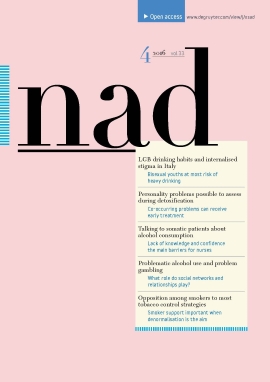
Exploring smokers’ opposition to proposed tobacco control strategies
Smokers are in favour of legislation that targets passive smoking, but defend their right to smoke in most public spaces. According to Marianne Lund, smokers opposed most of the proposed tobacco control strategies. Their support may be more important in tobacco control areas that aim to denormalise smoking and where enforcement is more complex. Helen Keane and Tove Sohlberg have written commentaries.
Risky drinking among Norwegian students
Solbjørg Makalani Myrtveit and colleagues investigate whether participation in the introductory week at Norwegian universities is associated with risky drinking. They also investigate whether risky drinking is associated with academic performance.
Factors influencing whether nurses talk to somatic patients about their alcohol consumption
Many Danes drink so much that it is detrimental to their health. As they are at risk of suffering diseases which can lead to hospitalisation on somatic wards, hospitals are ideal arenas for identifying individuals whose alcohol consumption is excessive. Rikke Hellum, Lene Bjerregaard and Anette Søgaard Nielsen identify potential factors that influence whether or not nurses talk to patients about their alcohol consumption on somatic wards. They also examine whether a screening project may affect the nurses’ readiness to talk about alcohol use with their patients.
Assessment of personality problems among patients with substance use disorders
Several studies have shown that personality disorders are frequently occurring among patients with substance use disorders. Ingebjørg Aspeland Lien and Espen Ajo Arnevik explore whether personality problems might be assessed among SUD patients in early stages of treatment.
Binge drinking and internalised sexual stigma among Italian lesbian, gay and bisexual young adults
Lesbian, gay and bisexual (LGB) young people are at increased risk to develop alcohol-related problems compared to heterosexuals. Valeria Verrastro and colleagues describe alcohol use patterns in relation to alcohol expectancies, internalised sexual stigma and sensation seeking and to highlight the specific risk factors that sexual minority subgroups face.
Problematic alcohol use and problem gambling
This study by Johanna Nordmyr, Anna K. Forsman and Karin Österman explores associations between structural and functional aspects of social networks and relationships (social ties) among individuals exhibiting problematic alcohol use and problem gambling, respectively. Functional aspects of individual-level social ties appear to be more relevant when studying problematic alcohol use or problem gambling, similarly to other forms of mental health problems.
Empowered communities: Science, ideology and the limits of political action
Filip Roumeliotis investigates how empowerment and democratic participation are conceptualized in the drug prevention program ‘Communities that Care’. The analysis is based on 13 publications written by program developers and other collaborators. He argues that the program may exert ‘ideological closure’ on the ability of communities to speak in properly political terms through disciplining communities into a common language that assert primacy of a (particular brand of) scientific reasoning.
NAD 3/2016 (June)
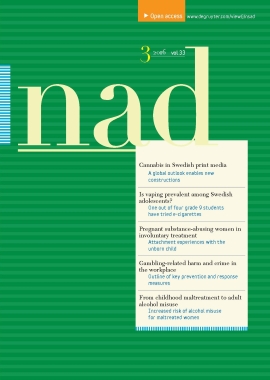
Continuity and change in Swedish print media constructions of cannabis
Josefin Månsson describes and analyses how cannabis is constructed in Swedish print media, and asks whether this has changed over time. The Swedish print media generally has a crime-centred and deterrent approach towards cannabis, with prohibition at the heart of the reporting. International events do however introduce discursive alternatives. It remains to be seen if these new ways of writing about cannabis will strengthen or challenge traditional Swedish prohibitionist constructions.
Pregnant substance-abusing women in involuntary treatment
Use of coercion against pregnant women who misuse substances was legalised in Norway in 1996. Siv Merete Myra and colleagues explored whether an attachment between the mother and her unborn child was possible in a context of coercion as experienced from the woman’s perspective. They found that involuntary detention enabled safety for and connection with the unborn child. Within this context, the pregnant substance-abusing women’s own relational experiences and developmental histories represent the most significant barrier for their ability to bond with the expected child.
Childhood maltreatment and alcohol misuse in a sample of Danish young adults
In their study, Susan Cronin, Siobhan Murphy and Ask Elklit examined the relationship between alcohol misuse and different types of childhood maltreatment in a sample of young adults. A significant relationship was found between childhood maltreatment and alcohol misuse. This relationship was significantly stronger for maltreated women, which identifies a gap in the literature. High associations between maltreatment and alcohol misuse in females may suggest alcohol is used as a coping strategy following childhood maltreatment.
Prevalence and risk factors of electronic cigarette use among adolescents
Is vaping prevalent among Swedish adolescents? Susanna Geidne and colleagues found that one out of four Swedish grade 9 students have tried e-cigarettes. They also found that the use of e-cigarettes tended to cluster with the use of other substances, such as other tobacco products and alcohol. The article is commented on by Karl E. Lund and Jaana M. Kinnunen.
Preventing and responding to gambling-related harm and crime in the workplace
Per Binde has studied gambling-related harm and crime in the workplace. In his outline of key prevention and response measures to problem gambling, he includes substance use and gambling policy, problem gambling awareness, attention to signs of gambling-related harm, control functions, appropriate responses to harmful gambling, and rehabilitation. According to Binde, the workplace should play a greater role in the universal, selective and indicated prevention of problem gambling
NAD 2/2016 (April)
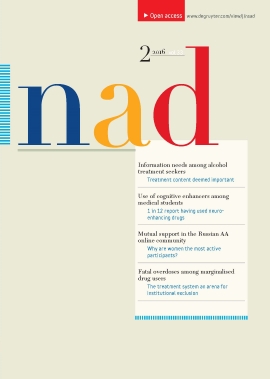
Exploring treatment culture and overdose in Norway
Research shows that the risk of overdose mortality among marginalized drug users is particularly high during the first weeks after discharge from inpatient treatment. Elin Berg investigated whether there might be a connection between marginalization and treatment culture to understand fatale overdoses after discharge from inpatient treatment. The case study is focused on a single individual and his treatment process in Norway. The case shows that there may be a relationship between marginality, treatment culture and overdose mortality. Cultural and structural aspects of the treatment system put subject in an empty and risky situation that probably contributed to his death.
Use of cognitive enhancers among medical students in Lithuania
Aistė Lengvenytė, Robertas Strumila and Jurgita Grikinienė have studied the use of cognitive enhancers among medical students in Lithuania.They wanted to determine the reasons for usage and evaluate the contributing factors such as socio-demographic characteristics, stress levels, sleep quality and knowing somebody who has used a neuro-enhancing drug. In Lithuania, 1 of 12 medical students report having used neuro-enhancing drugs. Male students reported three times higher prevalence rates than females.
Lack of information can be come a barrier for entering treatment
What kind of information do individuals in treatment for alcohol problems find should be available before treatment start? Anette Søgaard Nielsen and Annette Elkjær Ellermann found that by far the most participants rated information about the content of treatment as a priority. Individuals seeking and entering treatment for alcohol problems require information about the treatment itself and what it contains before they start treatment. This is in stark contrast to the kind of information that treatment seekers currently find, such as the opening hours of the treatment centre and similar practicalities. The article is followed with three commentaries by Jessica Storbjörk, Katja Kuusisto and Morten Hesse.
Mutual support and recovery in the Russian Alcoholics Anonymous online community
In Russia the paradigm of alcoholism as a disease is still in contrast to the general perception of alcoholics as weak-willed. Laura Lyytikäinen studied alcoholism and recovery in Russia by looking at the Russian Alcoholics Anonymous online group. The online community creates a space for engagement with AA’s 12-Step program and service work of supporting other alcoholics in recovery in the context of Russia, where face-to-face AA groups and other recovery programmes are scarce. When the state cannot deliver the services for problem drinkers or recovering alcoholics, people may turn to the Internet to find alternative information and social support.
NAD 1/2016 (February)
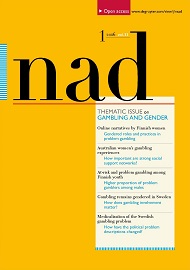
Thematic issue on gambling and gender
Significant life events and social connectedness in Australian women’s gambling experiences
Elaine M. Nuske, Louise Holdsworth and <b>Helen Breen examine the relation between significant life events, social connections and gambling among Australian female gamblers. Pierre Bourdieu’s and Robert D. Putnam’s theories on social capital are used to understand women’s gambling engagement and gambling-related problems.
Problem gambling and drinking among Finnish women
Johanna Järvinen-Tassopoulos analyses the relation between gender and addiction in short online narratives written by Finnish female problem gamblers. The women’s problematic gambling behaviour casts light on relationships and the gendered roles within the family. The qualitative data gives also an insight into female problem gamblers’ relation to drinking.
A gender perspective on gambling clusters in Sweden using longitudinal data
Ulla Romild, Jessika Svensson and Rachel Volberg use the Swedish Longitudinal Gambling Study (SWELOGS) data to study past-year gambling participation (cf. frequency and forms of gambling) by gender among 16 to 84-year-old respondents. Different clusters are identified representing various forms of gambling participation and indicating gender and socio-demographic differences between and within them.
At-risk and problem gambling among Finnish youth
Robert Edgren and colleagues explore the association between at-risk gambling, problem gambling, risky alcohol consumption, tobacco smoking, poor mental health and loneliness among 15 to 28-year-old Finnish males and females. The data is derived from the Finnish Gambling Survey 2011. The study also reviews the meanings of risky behaviours among adolescents and emerging adults and the impact of gender and age in the development of problems.
From boredom to dependence: The medicalisation of the Swedish gambling problem
Johan Edman and Josefine Berndt study the medicalisation of gambling in Sweden by comparing discussion protocols and parliamentary bills from the early 1970s to the early 2010s. The political handling of the gambling problem reveals the process of medicalisation of misuse, but it also points out major social and economic changes in the Swedish society.
NAD 5/2015 (November)
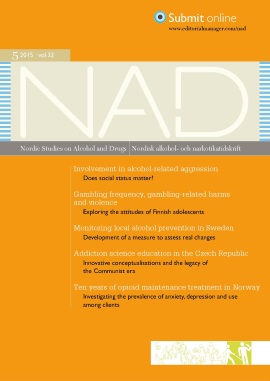
Involvement in alcohol-related verbal or physical aggression. Does social status matter?
In their analyses of a large sample of Swedes (N=104316), Ludwig Kraus and colleagues assessed the association between social status variables and aggression when controlling for volume of alcohol consumption and episodic heavy drinking (EHD), tested whether social status moderates the association between volume or EHD and verbal as well as physical aggression, and investigated whether EHD moderates the effect of volume on aggression. They found that groups of lower educated and nonmarried individuals experience verbal or physical aggression over and above different levels of consumption.
Gambling, violent behaviour and attitudes towards violence among adolescent gamblers in Finland
Tiina Räsänen and colleagues explored the relationship between gambling and violent behaviour and attitudes towards violence among 14- and 16-year-old Finnish adolescents. They found that both gambling frequency and the number of gambling-related harms were linked to violent behaviour as well as to positive attitudes towards violence. Adolescents who engaged in gambling on a daily basis and/or experienced gambling harms had the highest risk.
Monitoring local alcohol prevention in Sweden
Swedish municipalities carry out a variety of alcohol prevention activities, but there is little knowledge of how these have developed over time, due partly to the lack of tools for monitoring prevention activities locally. In this study Tony Nilsson, Håkan Leifman and Sven Andréasson develop an Alcohol Prevention Magnitude Measure (APMM) based on local data, and analyse the development of local alcohol prevention by using APMM. The results reveal that local alcohol prevention in Sweden, as measured by the APMM, has increased generally between 2006 and 2010 as a result of more local policies and activities.
Ten years of maintenance treatement in Norway
The national Opiate Maintenance Treatment (OMT) program in Norway started officially in 1998. Edle Ravndal and Grethe Lauritzen investigate the prevalence of live OMT patients in the total sample after 10 years, and compare the outcome of primarily substance abuse, anxiety and depression among OMT patients versus non-OMT patients. The OMT-group reported to a larger extent more anxiety and depression throughout the total observation period than the non OMT participants. Use of heroin and criminality were significantly reduced in both groups, but the OMT patients had more difficulties in reducing the use of benzodiazepines and cannabis.
Dynamic control important for substance abuse treatment in Norwegian prisons
The treatment of prison inmates in the Nordic countries has been described as humane and welfare-oriented. Janne Henriette Ingarsdotter Helgesen explores how key actors working in 13 substance treatment units in Norwegian prisons assess the responsibilities, working methods and goal attainment of these units, and how their descriptions fit the idea of a Nordic exceptionalism. The main pattern that emerges from this study supports that welfare orientation and ideas about therapy and rehabilitation are priorities in work with imprisoned substance users in substance
The creation of addictology behind the iron curtain
In their perspective article, Mihal Miovsky and colleagues seek to identify, describe and explain important events in shaping the historical context where the Czech education in addiction science and conception of addictology were developed. Because of the Iron Curtain, Czech practitioners had to develop their own concept of addiction and ideas on training psychotherapists so they could not be labelled western or anti-state, or be subject to intense state control.
NAD 4/2015 (September)
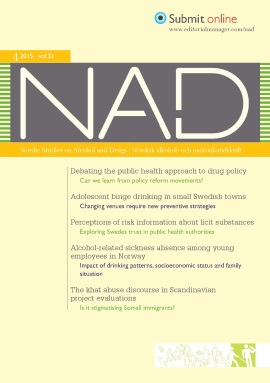
The compartmentalisation of social science: What are the implications?
In our editorial Matilda Hellman deliberates differences between basic and applied research. In the social sciences researchers have become specialised experts inhabiting narrow compartments of knowledge production. What does this mean for the future alcohol and drug research?
Four lessons from drug policy reform movements
<b>Ole Rogeberg</b> discusses how a public health approach sometimes fails to capture several concerns seen as important by recent drug policy reform movements, such as the full harms of illegal markets, the subjectively valued consumption of intoxicants, the dysfunctionality of current policy processes in the drug field and the value of the knowledge gained from policy experiments. Commentaries by Thomas Babor and Robin Room.
Targeting khat or targeting Somalis? A discourse analysis
In Scandinavia, the use of the psychoactive plant khat is widely seen as a social and health problem exclusively affecting the Somali immigrant population. Johan Nordgren has analysed the khat abuse discourse as it is presented in evaluation reports describing projects initiated by the social services to reduce khat abuse. According to Nordgren, overreliance on cultural explanations overlooks socioeconomic issues and that the focus should be on potentially problematic patterns of khat use rather than Somali immigrants in general.
The credibility of risk information about licit substances among Swedish adults
In this exploratory study, Mats Ekendahl and Patrik Karlsson analyse how Swedish adults trust and perceive risk information regarding alcohol, cigarettes and wet snuff (“snus”) provided by public authorities. The study suggests that attitudes on risk information are substance-specific and associated in complex ways with gender, age, education and experience of own substance use. The study indicates that the general population in Sweden receives what is seen as an adequate amount of knowledge from public authorities, and finds it consistent and trustworthy.
Alcohol-related sickness absence of young employees in Norway
Combining survey and register-based data, Line Schou and Gunn Birkelund have studied whether there are differences in alcohol-related sickness absence according to socioeconomic status and family situation among young employees in Norway. They have also assessed whether differences can be attributed mainly to differences. The authors found that alcohol-related sickness absence is more common among people who are single and without children, and more common among men than women. With the exception of income, socioeconomic factors do not seem to be important. The differences between groups appeared to be only partly a result of different drinking patterns.
Changing arenas of underage adolescent binge drinking in Swedish small towns
Using an ethnographic approach, Birgitta Ander and colleagues have explored arenas of adolescent binge drinking in small Swedish towns and the meanings these have for young persons. The focus of the article is on space and place, and on the geography of underage drinking. The authors found that adolescent binge drinkers have moved away from street and other outdoor drinking arenas to home environments, where they feel they have more control over their party location and participants.
NAD 2/2015 (April)
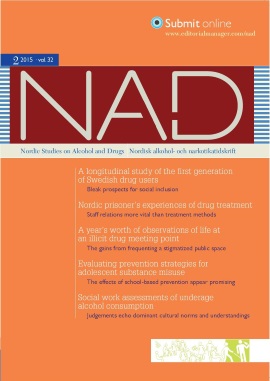
The social exclusion of Swedish drug users
What happened to the ‘first generation’ of drug Swedish users? In this Swedish language article <b>Susanne Alm</b> documents the social exclusion of drug users in Swedish society using a large data set of persons born in Stockholm in 1953 (Stockholm Birth Cohort Study). Very few of those with drug problems in their youth were able to establish a firm position in society in the long run. The article is followed by three commentaries in Swedish and Norwegian by Jessica Storbjörk, Edle Ravndal and Heini Kainulainen.
Prisoners’ experiences of drug treatment and punishment in four Nordic countries
Based on 91 qualitative interviews and 6 months of observations in 12 prisons, in Denmark, Finland, Norway and Sweden, the authors study how prisoners experience drug treatment, control and sanctions. Hedda Giertsen, Per-Åke Nylander, Vibeke Asmussen Frank, Torsten Kolind and Jouni Tourunen found that staff relations are regarded as more important than treatment methods, while controls and sanctions are seen as a part of everyday life in prison.
The Bench: An open drug scene and its people
Based on a year of participant observation this article describes life in an open illicit drug milieu in a Norwegian city. Trond Erik Grønnestad and Philip Lalander found that frequenting this stigmatized place with its everyday rituals is an expression of the need for dignity and human understanding among people who are regarded as urban outcasts.
Prevention of alcohol and drug misuse in adolescents: An overview of systematic reviews
Elke Emmers, Geertruida Elsiena Bekkering and Karin Hannes present an overview of recent systematic reviews, summarising the evidence on the effectiveness of prevention strategies that target substance misusing adolescents. There is a small but consistent positive effect of school-based prevention programmes.
Social work assessment of underage alcohol consumption in Sweden and Italy
In this cross-national focus group study Paolo Guidi and Matteo Di Placido ask thirty-five social workers employed in public social services in Stockholm, Malmö (Sweden), and Genoa (Italy) to assess and discuss a vignette story of underage alcohol consumption. The authors found that Italian social workers are in general more concerned and interventionist than are their Swedish colleagues who view teenage alcohol consumption as common behaviour.
NAD 1/2015 (February)
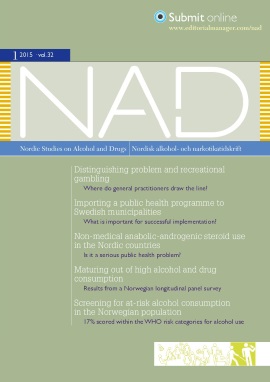
Anabolic-androgenic steroid use in the Nordic countries
How extensive is the non medical use of anabolic-androgenic steroids in the Nordic countries? Is it a public health problem? The analysis by <b>Dominic Sagoe</b> and colleagues included 32 studies that provided original data on 48 lifetime prevalence rates based on a total of 233,475 inhabitants from all five Nordic countries. Three commentaries are also available by Rafn Jónsson and Bilgrei och Sandøy with a reply from Sagoe och Pallesen. Kerstin Stenius also discusses the topic in her editorial.
From cannabis to problem drinking? Use and abuse from youth to adulthood
The transition to adulthood tends to entail changes in consumption of alcohol and drugs. In this Norwegian longitudinal panel study, Christer Hyggen and Torild Hammer study the relationship between cannabis and alcohol use in relation to adult roles and responsibilities.
One in five Norwegians engage in risky drinking
The population study by Torleif Halkjelsvik and Elisabet Storvoll use the AUDIT intrument to estimate the the proportion of the Norwegian population that according to the World Health Organization (WHO) guidelines should be followed up by primary health care, based on three levels of risk drinking. They found that 17% scored whithin these risk categories. (Abstract in English, article in Norwegian)
Hasardspel: var drar läkare gränsen mellan problematiskt och oproblematiskt beteende?
Allmänläkare är nyckelpersoner i bestämmandet av vad som betraktas som spelproblem. Författarna visar hur skillnaderna i problemdefinitioner verkar vara relaterade till vem som vårdar och hur spelandet regleras i tre länder: Finland, Frankrike och Tyskland. De pekar på hur viktigt det är att ha kulturell känslighet då man skapar rekommendationer för sociala interventioner. Studien baserar sig på fokusgruppsintervjuer.
Implementation of a multicomponent Responsible Beverage Service programme in Sweden
Ulrika Haggård and her co-authors identify factors that promote or hinder implementation of a multicomponent Responsible Beverage Service programme in Swedish municipalities. Suggestions on how to elude some of the hindering factors are proposed, e.g. to develop long-time financial plans, to provide better information about the RBS program in full, and to stress the importance of collaboration between representatives from the municipalities, police authorities and owners of on-licenced premises.
Significant others in substance abusers’ change talk in the Finnish Probation Service
This Finnish study by Harri Sarpavaara explores the meanings substance-abusing clients attach to family and friendships during motivational interviewing (MI) sessions in Probation Service. It is suggested that the meaning of significant others should not be overlooked in MI and other substance abuse treatment.

